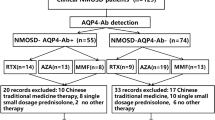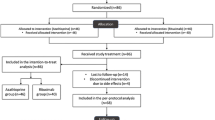Abstract
Neuromyelitis optical (NMO) and neuromyelitis optical spectrum disorder (NMOSD) are inflammatory autoimmune demyelination diseases affecting the central nervous system. We investigated the efficiency of low-dose rituximab treatment in 31 Chinese patients with NMO/NMOSD across a median period of 2.29 ± 0.97 years and azathioprine combined with corticosteroid treatment in 34 Chinese patients with NMO/NMOSD across a median period of 2.61 ± 0.94 years. Among the rituximab-treated patients, the mean Expanded Disability Status Scale (EDSS) was 5.62 ± 1.35 before treatment and 4.48 ± 0.78 at last follow-up, and the mean annualized relapse rate (ARR) was 1.39 ± 0.42 before treatment and 0.03 ± 0.13 at last follow-up. Among the azathioprine-treated patients, the mean EDSS was 5.63 ± 1.29 before treatment and 5.05 ± 1.00 at last follow-up, and the mean ARR was 1.28 ± 0.34 before treatment and 0.49 ± 0.21 at last follow-up. In this study, we showed that using low-dosage rituximab could benefit Chinese patients with NMO by reducing the new occurrence of relapses dramatically. Compared with the azathioprine-treated patients, we concluded that rituximab is more effective in preventing NMO relapse and could improve the symptoms.



Similar content being viewed by others
References
Morrow MJ, Wingerchuk D (2012) Neuromyelitis optica. J Neuroophthalmol 32(2):154–166
Wingerchuk DM, Lennon VA, Lucchinetti CF et al (2007) The spectrum of neuromyelitis optica. Lancet Neurol 6(9):805–815
Bizzoco E, Lolli F, Repice AM et al (2009) Prevalence of neuromyelitis optica spectrum disorder and phenotype distribution. J Neurol 256(11):1891–1898
Lucchinetti CF, Mandler RN, Mcgavern D et al (2002) A role for humoral mechanisms in the pathogenesis of Devic’s neuromyelitis optica. Brain 125(Pt 7):1450–1461
Pittock SJ, Lennon VA, Krecke K et al (2006) Brain abnormalities in neuromyelitis optica. Arch Neurol 63(3):390–396
Saadoun S, Bridges LR, Verkman AS et al (2012) Paucity of natural killer and cytotoxic T cells in human neuromyelitis optica lesions. NeuroReport 23(18):1044–1047
Trebst C, Jarius S, Berthele A et al (2014) Update on the diagnosis and treatment of neuromyelitis optica: recommendations of the Neuromyelitis Optica Study Group (NEMOS). J Neurol 261(1):1–16
Kimbrough DJ, Fujihara K, Jacob A et al (2012) Treatment of neuromyelitis optica: review and recommendations. Mult Scler Relat Disord 1(4):180–187
Grillo-Lopez AJ (2000) Rituximab: an insider’s historical perspective. Semin Oncol 27(6 Suppl 12):9–16
Jarius S, Aboul-Enein F, Waters P et al (2008) Antibody to aquaporin-4 in the long-term course of neuromyelitis optica. Brain 131(Pt 11):3072–3080
Pellkofer HL, Krumbholz M, Berthele A et al (2011) Long-term follow-up of patients with neuromyelitis optica after repeated therapy with rituximab. Neurology 76(15):1310–1315
Cree BA, Lamb S, Morgan K et al (2005) An open label study of the effects of rituximab in neuromyelitis optica. Neurology 64(7):1270–1272
Jacob A, Weinshenker BG, Violich I et al (2008) Treatment of neuromyelitis optica with rituximab: retrospective analysis of 25 patients. Arch Neurol 65(11):1443–1448
Kim SH, Kim W, Li XF et al (2011) Repeated treatment with rituximab based on the assessment of peripheral circulating memory B cells in patients with relapsing neuromyelitis optica over 2 years. Arch Neurol 68(11):1412–1420
Bedi GS, Brown AD, Delgado SR et al (2011) Impact of rituximab on relapse rate and disability in neuromyelitis optica. Mult Scler 17(10):1225–1230
Kim SH, Huh SY, Lee SJ et al (2013) A 5-year follow-up of rituximab treatment in patients with neuromyelitis optica spectrum disorder. JAMA Neurol 70(9):1110–1117
Jacob A, Weinshenker BG, Violich I et al (2008) Treatment of neuromyelitis optica with rituximab: retrospective analysis of 25 patients. Arch Neurol 65(11):1443–1448
Mealy MA, Wingerchuk DM, Palace J et al (2014) Comparison of relapse and treatment failure rates among patients with neuromyelitis optica: multicenter study of treatment efficacy. JAMA Neurol 71(3):324–330
Yang CS, Yang L, Li T et al (2013) Responsiveness to reduced dosage of rituximab in Chinese patients with neuromyelitis optica. Neurology 81(8):710–713
Kim HJ, Kim SH (2014) Responsiveness to reduced dosage of rituximab in Chinese patients with neuromyelitis optica. Neurology 82(6):546–547
Qiu W, Kermode AG, Li R et al (2015) Azathioprine plus corticosteroid treatment in Chinese patients with neuromyelitis optica. J Clin Neurosci 22(7):1178–1182
Costanzi C, Matiello M, Lucchinetti CF et al (2011) Azathioprine: tolerability, efficacy, and predictors of benefit in neuromyelitis optica. Neurology 77(7):659–666
Bichuetti DB, Lobato DOE, Oliveira DM et al (2010) Neuromyelitis optica treatment: analysis of 36 patients. Arch Neurol 67(9):1131–1136
Sahraian MA, Moinfar Z, Khorramnia S et al (2010) Relapsing neuromyelitis optica: demographic and clinical features in Iranian patients. Eur J Neurol 17(6):794–799
Wingerchuk DM, Banwell B, Bennett JL et al (2015) International consensus diagnostic criteria for neuromyelitis optica spectrum disorders. Neurology 85(2):177–189
Watanabe S, Misu T, Miyazawa I et al (2007) Low-dose corticosteroids reduce relapses in neuromyelitis optica: a retrospective analysis. Mult Scler 13(8):968–974
Zephir H, Bernard-Valnet R, Lebrun C et al (2015) Rituximab as first-line therapy in neuromyelitis optica: efficiency and tolerability. J Neurol 262(10):2329–2335
Mealy MA, Wingerchuk DM, Palace J et al (2014) Comparison of relapse and treatment failure rates among patients with neuromyelitis optica: multicenter study of treatment efficacy. JAMA Neurol 71(3):324–330
Acknowledgements
This work was supported by a Grant from the Natural Science Foundation of Shanxi Province, China (Grant Number 2013011052-3).
Author information
Authors and Affiliations
Contributions
MZ formulated the study concept, supervised the execution of the study, provided the funding, and wrote the manuscript. CZ and PB recruited the patients, executed the treatment regimen, assessed the patients, and analyzed the patient data during therapy. HX participated in the manuscript preparation. GW processed the blood samples, performed the flow cytometry, and analyzed the laboratory results.
Corresponding author
Ethics declarations
Conflict of interest
The authors declare that they have no financial and personal relationships with other people or organizations that can inappropriately influence our work. There is no professional or other personal interest of any nature or kind in any product, service or company that could be construed as influencing the position presented in, or the review of, the manuscript.
Ethical standards
All procedures performed in studies involving human participants were approved by the Shanxi Medical University Ethical Review Board. This article does not contain any studies with animals performed by any of the authors.
Informed consent
Informed consent was obtained from all individual participants included in the study.
Rights and permissions
About this article
Cite this article
Zhang, M., Zhang, C., Bai, P. et al. Effectiveness of low dose of rituximab compared with azathioprine in Chinese patients with neuromyelitis optica: an over 2-year follow-up study. Acta Neurol Belg 117, 695–702 (2017). https://doi.org/10.1007/s13760-017-0795-6
Received:
Accepted:
Published:
Issue Date:
DOI: https://doi.org/10.1007/s13760-017-0795-6




